Balut, known as “trứng vịt lộn” or “hột vịt lộn” in Vietnamese, is a delicacy representative of Vietnam’s rich cultural and culinary landscape. This unique dish is made from fertilized duck eggs, incubated until the embryo reaches a certain stage of development before being boiled or steamed for consumption. Often regarded with a mixture of fascination and hesitation, balut intrigues adventurous eaters and provides a staple for locals. Balut is enjoyed not only for its exceptional taste and texture but also for its symbolic cultural significance, reflecting Vietnam’s traditional agricultural practices and modern gastronomic heritage. Balut offers a sensory journey that embodies the vibrancy and diversity of Vietnamese street food culture.
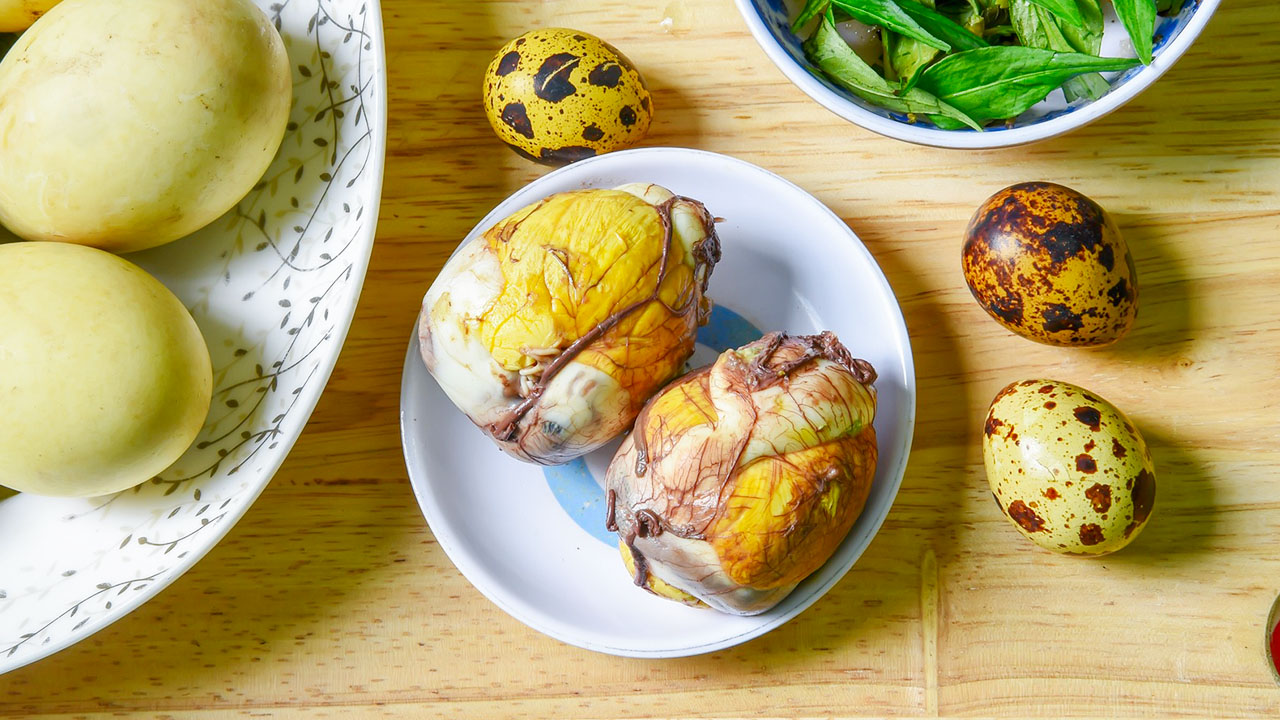
What Is Balut?
Balut is a culinary specialty made from fertilized duck eggs, where the embryo has developed to a specific stage, usually between 14 to 21 days of incubation. Imagine unwrapping a culinary gift inside, the delicate balance of yolk, embryo, and rich amniotic fluid await, each contributing to a unique sensory experience. Balut differs from your everyday egg despite resembling it in initial appearance; it promises a more complex flavor and texture as the embryo matures. This delicacy is enjoyed by sipping the savory broth and savoring the yolk and embryo, often enhanced with salt, pepper, lime, and Vietnamese coriander.
Description and Characteristics
Balut’s preparation starts with selecting fertilized duck eggs that have been incubated for an optimal period, generally 17 to 21 days. During this incubation, the embryo inside the egg begins to develop, leading to the formation of bones, feathers, and body structure, subtly altering its flavor profile compared to a regular chicken egg. The unique combination of its components yolk, embryo, and amniotic fluid creates a culinary mosaic that’s richly textured and flavor-forward.
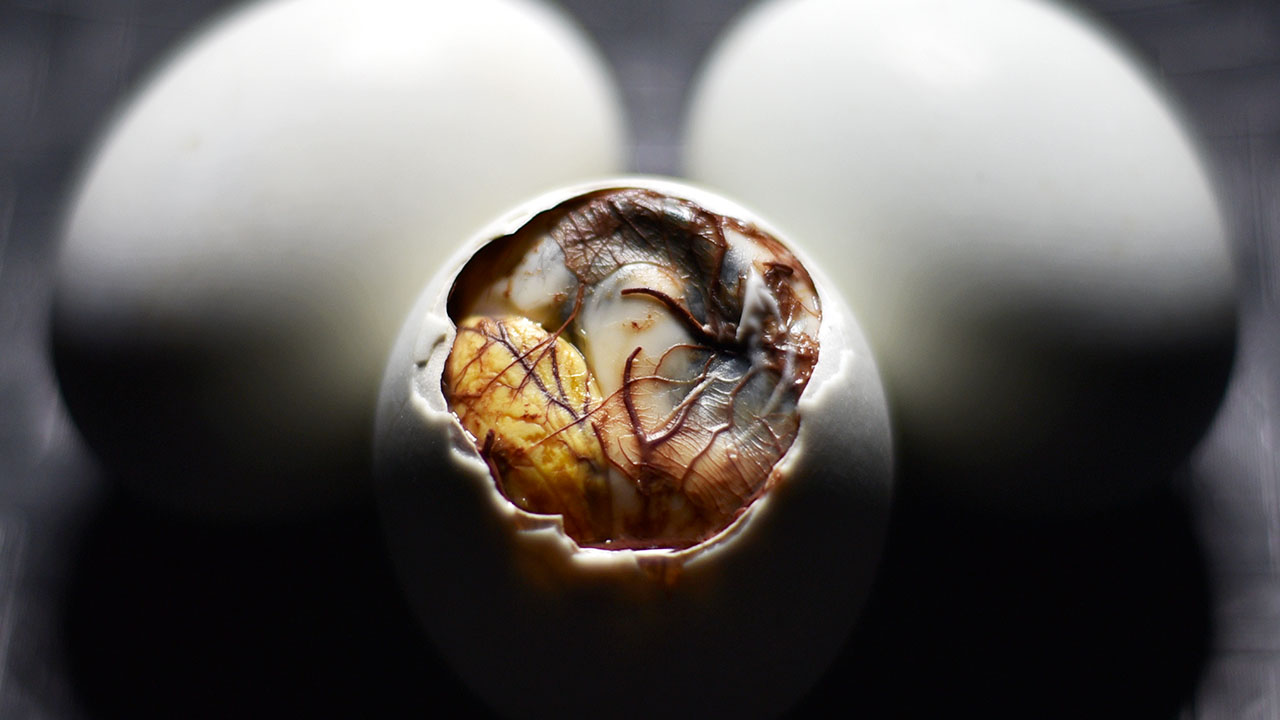
When boiled or steamed, the broth in the egg becomes savory and rich, akin to a concentrated chicken stock but with a more nuanced taste profile. This broth is usually the first point of contact for eaters sipped directly after the shell is cracked open, it provides a warm and comforting introduction. The yolk, rich and slightly gamey, offers a creamy texture, while the embryo brings a meaty contrast that is both unexpected and satisfying.
Balut’s appeal lies not only in its taste but in its intricate preparation process that ensures the embryo is developed just right. The eggs are typically boiled for about 20 to 30 minutes, ensuring that the brothy, yolky, and embryonic components are perfectly cooked. Gently tapping the top of the egg, many diners savor the broth first, followed by bites of the yolk and embryo.
Here’s a breakdown of balut’s components:
| Component | Description |
|---|---|
| Broth | Savory and rich, provides the initial sip of flavor. |
| Yolk | Creamy and slightly gamey, rich in texture. |
| Embryo | Meaty with a tender texture; the most distinct part. |
To enhance the taste, balut is often served with a mix of seasonings, including salt, pepper, lime, and sometimes chili. Fresh herbs like Vietnamese coriander add an aromatic freshness that balances the rich flavors. The experience combines the sensory joy of tasting different textures and flavors, making balut a cherished yet adventurous delicacy.
Cultural Significance in Vietnam
Balut is not merely a culinary curiosity; it is an integral part of Vietnamese culture and cuisine, deeply rooted in traditional practices. In Vietnam, balut’s significance extends beyond its unique taste, reflecting agricultural heritage and communal dining practices, embodying the connection between food, tradition, and social interaction.
Balut, or “trứng vịt lộn,” is commonly consumed across different regions in Vietnam, from bustling urban markets to tranquil rural areas. Its presence is a testament to the resourcefulness and ingenuity of Vietnamese agricultural practices. By utilizing fertilized duck eggs, the Vietnamese maximize their resources, reflecting a deep respect for nature and sustainability.
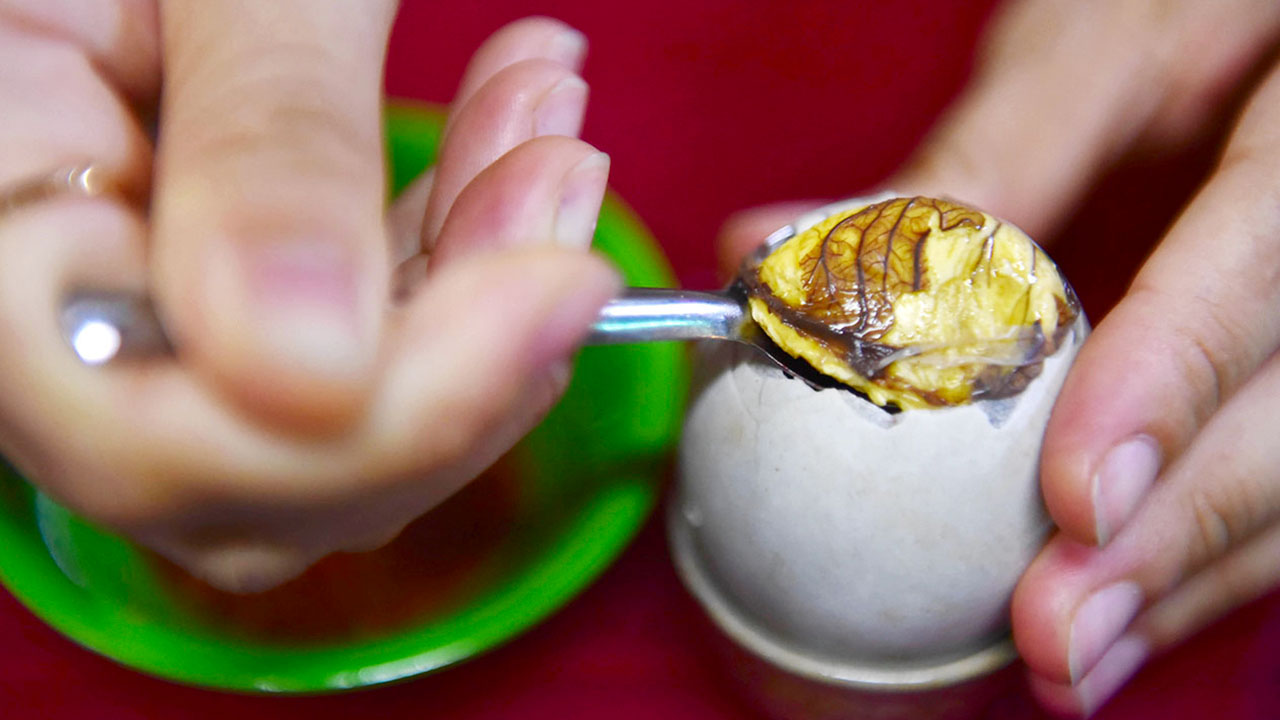
During festive occasions and family gatherings, balut often makes an appearance as a shared dish, symbolizing unity and communal enjoyment. The preparation and eating of balut encourage social interaction, with family members and friends gathering around, sharing stories and experiences as they crack open these intriguing eggs.
In Vietnamese folklore, balut is also believed to enhance health and vitality. It is commonly recommended as a nutritious food for pregnant women, thought to contribute to the health of both mother and child due to its rich nutrient content. These cultural beliefs further embed balut in the everyday life of Vietnamese people, creating a blend of culinary enjoyment and traditional wisdom.
Tourists often approach balut with a mixture of curiosity and apprehension, encouraged by locals who regard it as a must-try experience that epitomizes Vietnamese street food culture. The dish often serves as a conversation starter, bridging cultural gaps and creating memorable moments for travelers. For locals, sharing balut with newcomers is an act of hospitality and pride, showcasing the rich culinary traditions of their heritage.
The cultural significance of balut is multifaceted, encompassing elements of agriculture, tradition, health beliefs, and social interaction. It is not just a dish but a representation of Vietnamese identity, cherished for its deep-rooted traditions and the sense of community it fosters.
Types of Balut
Balut in Vietnam can be categorized based on the stage of embryo development. For example:
- Young Balut (non): Harvested at 17 to 19 days of incubation, featuring a smaller embryo and more yolk.
- Old Balut (già): Collected at 20 to 21 days of incubation, with a more developed embryo and stronger flavors.
These variations cater to different preferences, with young balut often recommended for first-time eaters due to its milder taste, while seasoned eaters might favor the robust flavor of older balut.
Regional Variations in Preparation
Different regions in Vietnam offer distinct takes on balut, reflecting local tastes and culinary practices. In Northern Vietnam, balut preparation often includes fresh herbs such as Vietnamese coriander (rau răm) and a dipping sauce made of salt, pepper, and lime juice. This combination accentuates the natural flavors of the egg while providing a refreshing contrast with the herbs and citrus.
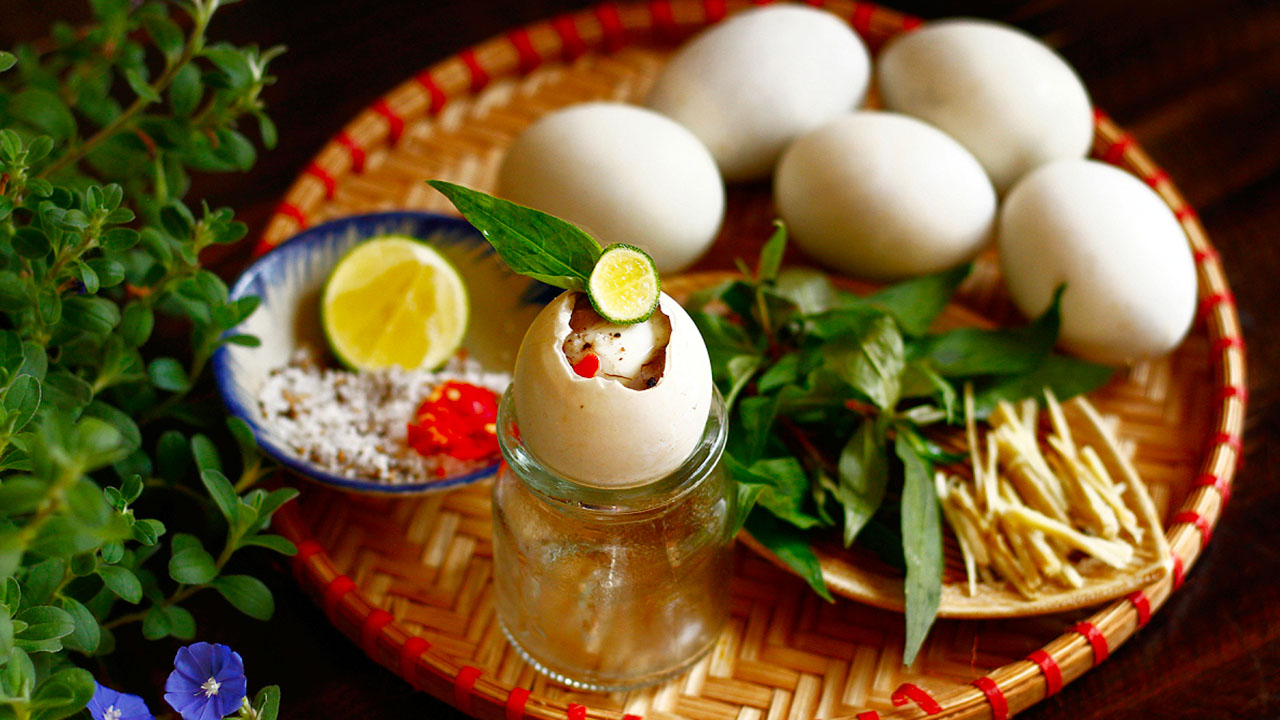
In Central Vietnam, the preparation may include additional ingredients like ginger and chili, enhancing the heat and spice level of the dish. Some recipes also suggest stir-frying balut with tamarind sauce, creating a rich and tangy flavor profile that balances the egg’s richness with the tamarind’s sourness. This variation is popular in regions known for their bold and flavorful cuisine.
In Southern Vietnam, balut is often served with unique accompaniments such as fermented fish sauce, which adds a deep umami flavor, and fresh herbs like mint. This combination offers a distinct tasting experience, emphasizing the interplay between the richness of the egg and the umami from the fish sauce, complemented by the fresh aroma of the herbs.
Here are some regional styles of preparing balut:
| Region | Preparation Style |
|---|---|
| Northern Vietnam | Served with fresh herbs, salt-pepper-lime sauce. |
| Central Vietnam | Includes ginger, chili, or stir-fried with tamarind. |
| Southern Vietnam | Accompanied by fermented fish sauce and fresh mint. |
These variations highlight the adaptability and regional diversity of Vietnamese cuisine, allowing balut to be enjoyed in multiple ways that cater to different tastes and preferences. Each region’s approach to balut reflects its culinary heritage, making it a versatile and richly flavorful delicacy across the country.
Differences Between Duck and Chicken Balut
While duck balut is the most common, chicken balut is also available, offering distinct differences in taste and texture. Duck balut generally has a richer, more savory flavor, with a slightly gamey undertone. The yolk is creamy, and the embryo is more developed, providing a unique texture that combines tender and meaty elements.
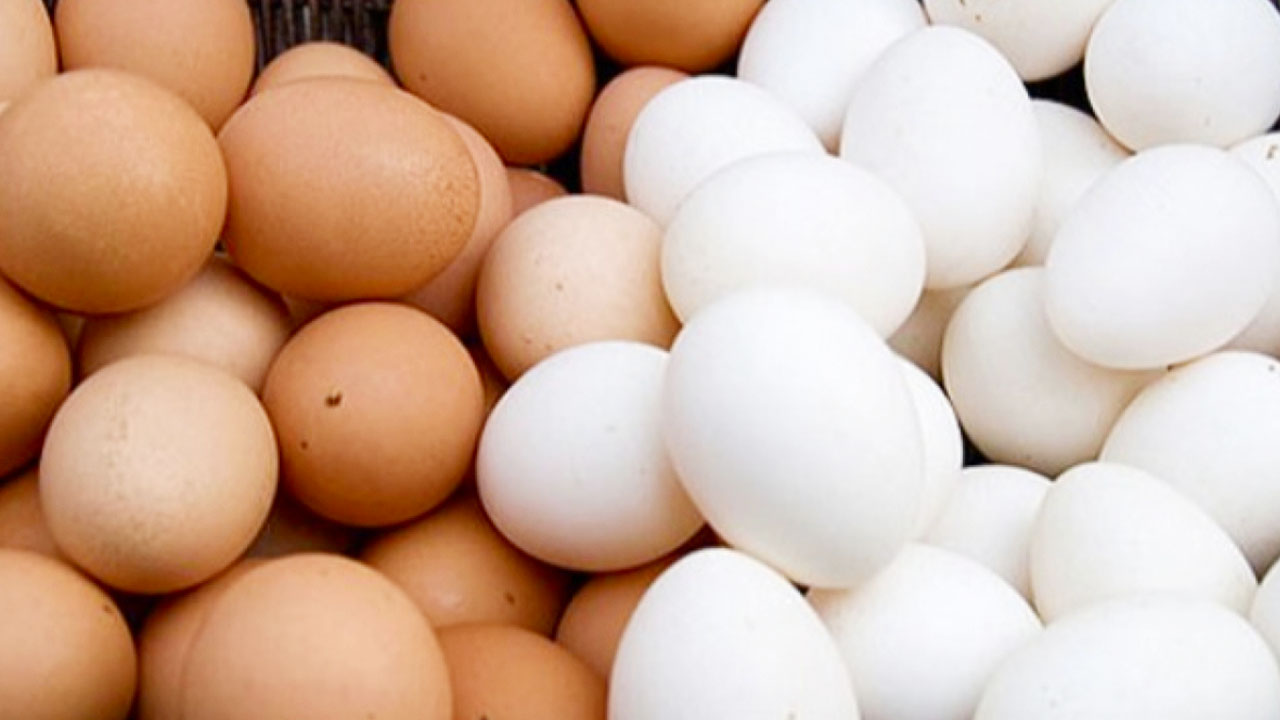
In contrast, chicken balut tends to have a milder flavor and a less developed embryo, often resulting in a more delicate and subtle tasting experience. The yolk of chicken balut is typically smoother and less creamy compared to duck balut, making it a preferred choice for those new to this delicacy.
Here’s a comparison between duck and chicken balut:
| Difference | Duck Balut | Chicken Balut |
|---|---|---|
| Flavor | Rich, savory, slightly gamey | Milder, more subtle |
| Yolk Texture | Creamy, rich | Smoother, less creamy |
| Embryo | More developed, tender, meaty | Less developed, delicate |
Both types offer unique culinary experiences, but the choice between duck and chicken balut often comes down to personal preference. Duck balut appeals to those who enjoy bold, savory flavors with complex textures, while chicken balut provides a gentler introduction to this traditional delicacy.
Cooking Methods
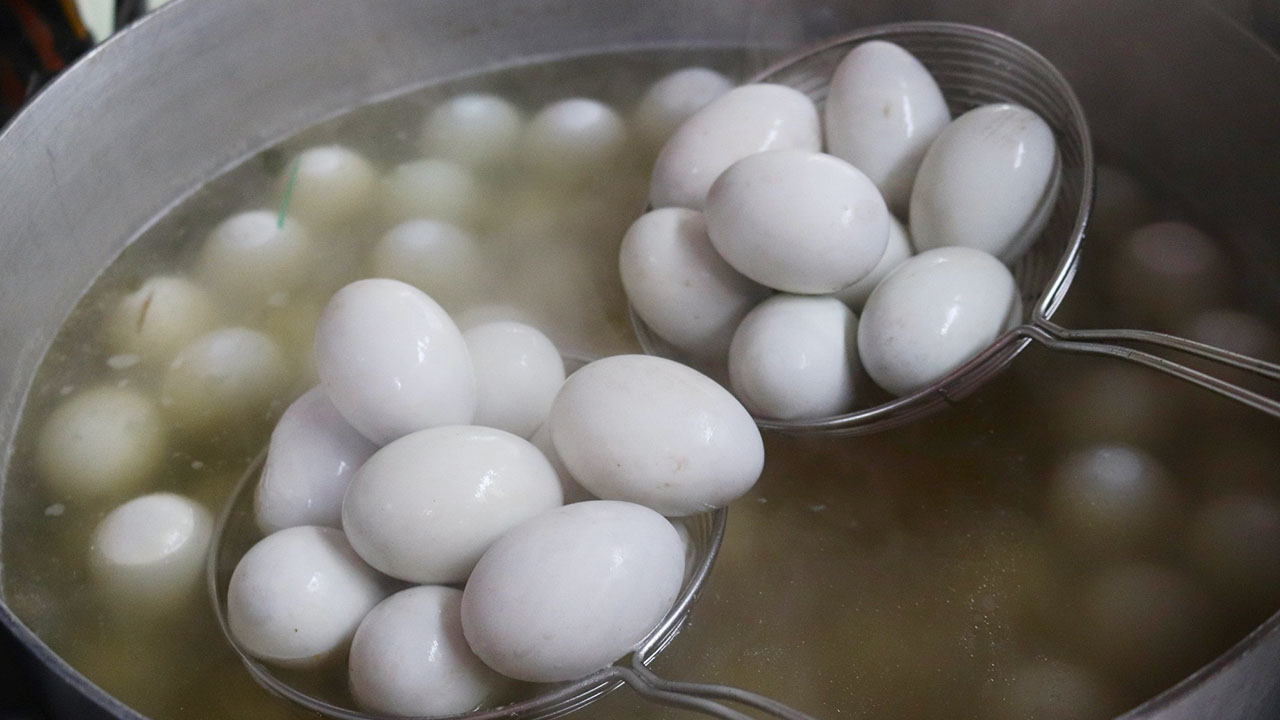
Balut, known as “hột vịt lộn” in Vietnamese, is prepared using various cooking techniques that enhance its natural flavors and textures.
Traditional Boiling Techniques
Traditional boiling is the most common method of preparing balut. Here’s a step-by-step guide to ensure perfect preparation:
Ingredients and Preparation
- Fertilized Duck Eggs: Choose eggs that are 17 to 21 days old.
- Water: Ensure enough to cover the eggs completely.
- Salt: Add a pinch to the water to prevent cracking.
Boiling Process
- Step 1: Fill a pot with water and bring it to a rolling boil.
- Step 2: Carefully place the eggs into the boiling water using a slotted spoon.
- Step 3: Reduce heat to medium and simmer for 20-30 minutes.
- Step 4: Remove eggs and allow them to cool slightly before serving.
Serving
- Sauces: Serve with a mixture of salt, ground black pepper, and lime or lemon juice.
- Herbs: Garnish with Vietnamese coriander (Rau Ram).
This method ensures the eggs are cooked evenly, resulting in a flavorful broth, creamy yolk, and tender embryo. The combination of salt, pepper, and lime enhances the dish’s natural flavors, creating a savory and refreshing taste experience.
Alternative Cooking Methods
Apart from traditional boiling, balut can be prepared using various alternative methods, each offering distinct flavor profiles:
Stir-Frying
Stir-frying balut with tamarind sauce provides a tangy twist to this traditional dish. Here’s how it’s done:
- Ingredients: Tamarind sauce, garlic, and peanuts.
- Method: After boiling, stir-fry balut with tamarind sauce and garlic until well-coated. Garnish with peanuts and Vietnamese mint.
Grilling
Grilling balut offers a smoky flavor:
- Ingredients: Chili sauce made from shallots, garlic, and coriander.
- Method: After boiling, crack the eggs into cups, mix with chili sauce, and grill until edges caramelize.
Soups and Congee
Adding balut to soups or congee creates a hearty meal:
- Ingredients: Minced meat, vegetables, and rice congee.
- Method: Boil the eggs and add them to congee, stirring in minced meat and vegetables.
Boiling with Additives
Boiling balut with additional ingredients infuses it with sweet and aromatic flavors:
- Ingredients: Fresh ginger and coconut water.
- Method: Boil balut with ginger and coconut water for added aroma and sweetness.
These alternative methods highlight the versatility of balut, allowing it to be enjoyed in various forms. Each cooking method enhances the dish’s flavors and textures, making it adaptable to different culinary preferences.
Eating Balut
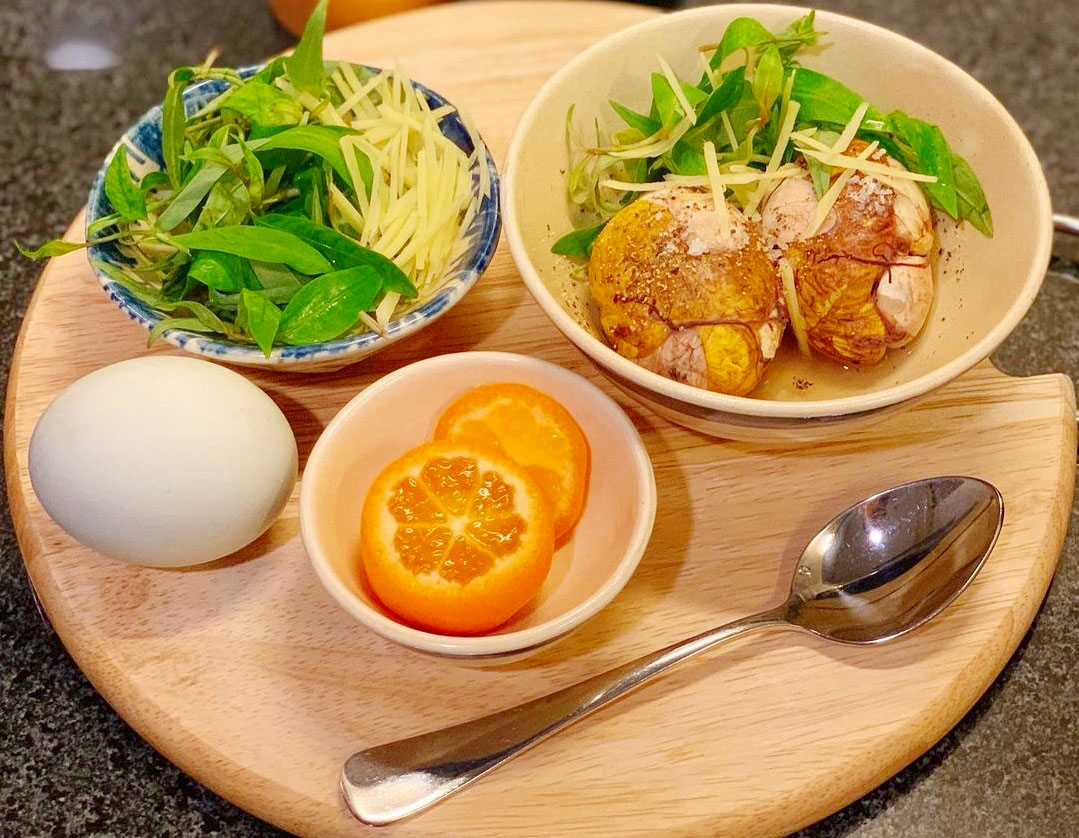
Eating balut involves a blend of traditional practices and personalized tastes, offering a unique culinary adventure. In Vietnam, balut is not just food; it is an experience steeped in cultural significance and social interaction.
Typical Accompaniments
In Vietnam, balut is often enjoyed with a variety of accompaniments that enhance its flavors:
- Salt and Pepper: A classic pairing that brings out the richness of the yolk and embryo.
- Lime or Lemon Juice: Adds a zesty contrast to the egg’s savory elements.
- Vietnamese Coriander (Rau Ram): Provides a fresh and aromatic counterpart.
- Chili Sauce: For those who prefer a bit of heat.
A popular method involves cracking the top of the egg and sipping the warm broth before savoring the yolk and embryo. The dipping sauces and herbs not only enhance the taste but also balance the egg’s rich flavors, creating a harmonious taste profile.
Regional Eating Practices
Eating balut varies by region, reflecting local preferences and traditions:
- Northern Vietnam: The egg is cracked into a small bowl, with the broth sipped first. Common accompaniments include sliced ginger, chili, and minced herbs.
- Central Vietnam: Balut is often eaten with tamarind sauce, adding a tangy twist. It may also be stir-fried with garlic and peanuts.
- Southern Vietnam: Presented upright in a glass, the egg is enjoyed with a mixture of salt, pepper, and lime juice. Herbs like Vietnamese coriander add freshness to the dish.
Cultural Practices
Balut is more than a food item; it is a symbol of Vietnamese hospitality and tradition. Eating balut at street stalls often becomes a social activity, bringing people together to share the experience. Tourists are encouraged to try it as a rite of passage, while locals proudly introduce them to this iconic dish.
Nutrition and Health Considerations
Balut is not only a culinary delicacy but also a nutrient-rich food with various health considerations.
Nutritional Benefits of Balut

Balut is packed with essential nutrients that contribute to a balanced diet:
- High Protein: Essential for muscle repair and growth.
- Vitamins and Minerals: Rich in vitamins A, B1, B2, and C, along with iron, calcium, and phosphorus.
- Beneficial Fats: Provides essential lipids for various bodily functions.
These nutrients make balut beneficial for various populations, including pregnant women and children. The protein and vitamins support growth and recovery, while the minerals enhance bone health and metabolic functions.
In comparison to regular chicken eggs, balut offers significantly higher levels of iron, calcium, and beta-carotene. This makes it particularly valuable for individuals with higher nutritional demands.
Health Risks and Dietary Restrictions
While balut offers numerous health benefits, it also comes with some considerations:
- Cholesterol Content: High in cholesterol, balut should be consumed in moderation, especially for individuals with hyperlipidemia or cardiovascular issues. Experts recommend limiting intake to 2-3 eggs per week.
- Bacterial Contamination: Potential risk of contamination, particularly from street vendors, necessitates caution in consumption.
- Caloric Density: Relatively calorie-dense, making moderation key for weight management.
- Allergy Considerations: Individuals with egg allergies should avoid balut.
Understanding these health considerations helps in making informed choices about incorporating balut into a balanced diet.
Balut as Street Food
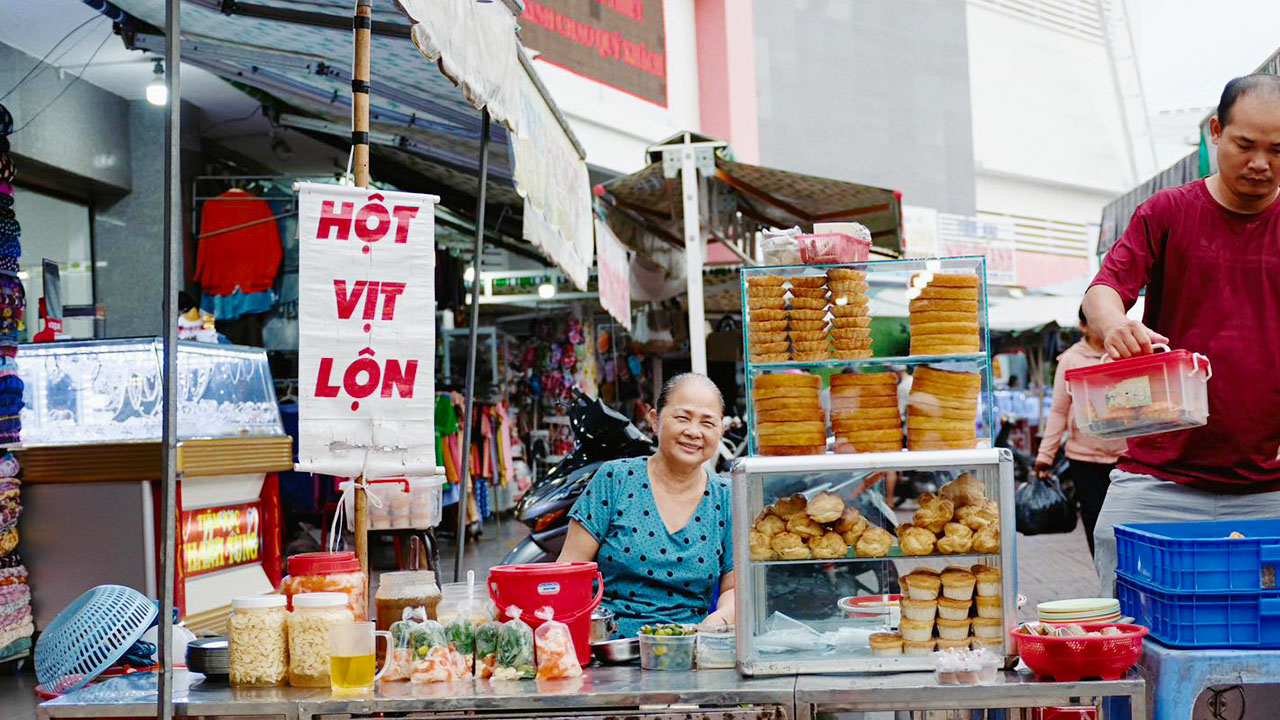
Balut is a celebrated street food in Vietnam, symbolizing the vibrant food culture that draws both locals and tourists.
Popular Locations for Balut in Vietnam
Balut is readily available across various regions in Vietnam, with popular locations including:
- Hanoi: Street stalls around the Old Quarter.
- Ho Chi Minh City: Ben Thanh Market and local eateries in Districts 1 and 3.
- Da Nang: Busy streets and night markets.
- Nha Trang: Beachfront stalls offering diverse variations.
Street Food Culture Surrounding Balut
The street food culture in Vietnam elevates balut from a mere dish to a communal experience:
- Preparation: Vendors meticulously boil the eggs, ensuring the right texture and flavor. Balut is served warm, often with dipping sauces and fresh herbs.
- Consumption: Eating balut often turns into a social activity, with people gathering around stalls to share the experience.
- Cultural Significance: For locals, balut represents tradition and hospitality, while for tourists, it’s an adventurous culinary exploration.
The presence of balut in Vietnamese street markets is a testament to the country’s rich culinary traditions and the communal spirit that thrives within its vibrant food culture.
Common Misconceptions
Balut often comes with various misconceptions that can deter people from trying it. Addressing these misconceptions helps in understanding and appreciating this unique delicacy.
Addressing Fear and Intrigue
Common misconceptions about balut include:
- Appearance: Many believe it contains fully developed ducks. However, the embryo is typically in an early stage, offering a blend of textures without overwhelming visual details.
- Taste and Smell: Balut is often assumed to have an offensive odor or taste. In reality, it has a rich, savory broth similar to chicken soup, enhanced with seasonings like salt, lime, and pepper.
- Cultural Appreciation vs. Novelty: Balut is dismissed as “weird food” by some, but it holds significant cultural value in Vietnam, enjoyed regularly and appreciated for its unique flavors.
- Health Concerns: While high in cholesterol, it offers various essential nutrients. Moderation is key to reaping its benefits without adverse health effects.
Understanding these misconceptions allows a more informed and open approach to trying balut, recognizing it as a symbol of Vietnamese culinary heritage.
Balut in Pop Culture
Balut’s portrayal in pop culture often amplifies its intrigue and fear factor:
- Media Representation: Often shown as a challenge dish, reinforcing its daunting reputation.
- Cultural Misunderstandings: Seen as a novelty or party food, overshadowing its traditional significance.
By exploring recipes and serving suggestions, one can appreciate balut’s culinary uniqueness beyond its controversial image.
Recipes and Serving Suggestions
Balut can be enjoyed in various creative ways, enhancing its flavors and making it accessible to different palates.
How to Prepare Balut at Home
Detailed steps to prepare balut at home include:
- Ingredients: Fertilized duck eggs, 14 to 21 days old.
- Cleaning and Boiling: Rinse eggs, boil in water for 20-30 minutes.
- Serving: Crack the top, sip the broth, and enjoy with seasonings like salt, pepper, and lime.
Creative Ways to Serve Balut
Balut can be served in innovative ways:
- Traditional Seasonings: Salt and pepper, vinegar, lime, and Vietnamese coriander.
- Balut with Ginger and Spices: Sliced ginger, chili, and soup powder.
- Serving in a Dish: Cracked into a bowl, mixed with herbs and sauces.
- Balut Nachos: Tortilla chips topped with shredded balut, spicy sauce, cheese, and herbs.
- Balut Salad: Mixed greens with balut, cilantro, and soy-vinegar dressing.
- Hotpot Addition: Added to hotpot dishes for enhanced flavor.
Exploring these recipes and serving ideas allows a deeper appreciation of balut’s versatility and cultural significance.
Conclusion and Personal Experience
Balut transcends its status as a mere food item, embodying the rich cultural and culinary heritage of Vietnam.### Testimonials from Locals and Tourists Balut is more than just a customary dish in Vietnam; it’s a rite of passage for many visitors and a cherished delicacy among locals. Here are some firsthand accounts that illustrate the emotional and sensory journey associated with tasting balut.
Local Perspectives
For many Vietnamese, balut is a staple that brings a sense of nostalgia and comfort. Locals often recount their first experiences with balut, shared with family members during holidays or late-night street food binges.
- Nguyen, Hanoi Resident: “I still remember the first time I tried balut. I was with my grandmother at the local night market. She cracked open the top, sprinkled a bit of salt and pepper, and handed it to me. The warmth, the broth, the richness of the yolk it was an unforgettable experience. Now, every time I have it, it takes me back to that moment, a simple yet profound connection to my roots.”
- Thi, Ho Chi Minh City Street Vendor: “Selling balut is more than a business; it’s sharing a piece of our culture. Tourists often approach with curiosity and hesitation, but by the end of their first taste, most are pleasantly surprised. It’s always rewarding to see their reactions transform from skepticism to delight.”
Tourist Experiences
For many tourists, tasting balut is an adventure, a culinary challenge that turns into a rewarding experience.
- John, Tourist from the U.S.: “When I heard about balut, I was both fascinated and a bit scared. It took some courage to take that first sip of the broth, but it was surprisingly delicious like a rich, warm soup. The texture of the yolk and the embryo was new to me, but the flavors were incredible. It really opened my eyes to the depth of Vietnamese cuisine.”
- Emily, Traveler from Australia: “I was hesitant at first, given balut’s reputation, but the vendor in Hanoi was so friendly and encouraging. I followed her instructions sip the broth, then eat the yolk and embryo with a bit of salt and lime. It ended up being one of the best food experiences of my trip. I felt a connection to the local culture that I wouldn’t have had by just sticking to familiar foods.”
These testimonials highlight the transformative nature of balut, from an initially daunting delicacy to a culinary delight that bridges cultural gaps.
Balut in Modern Vietnamese Cuisine
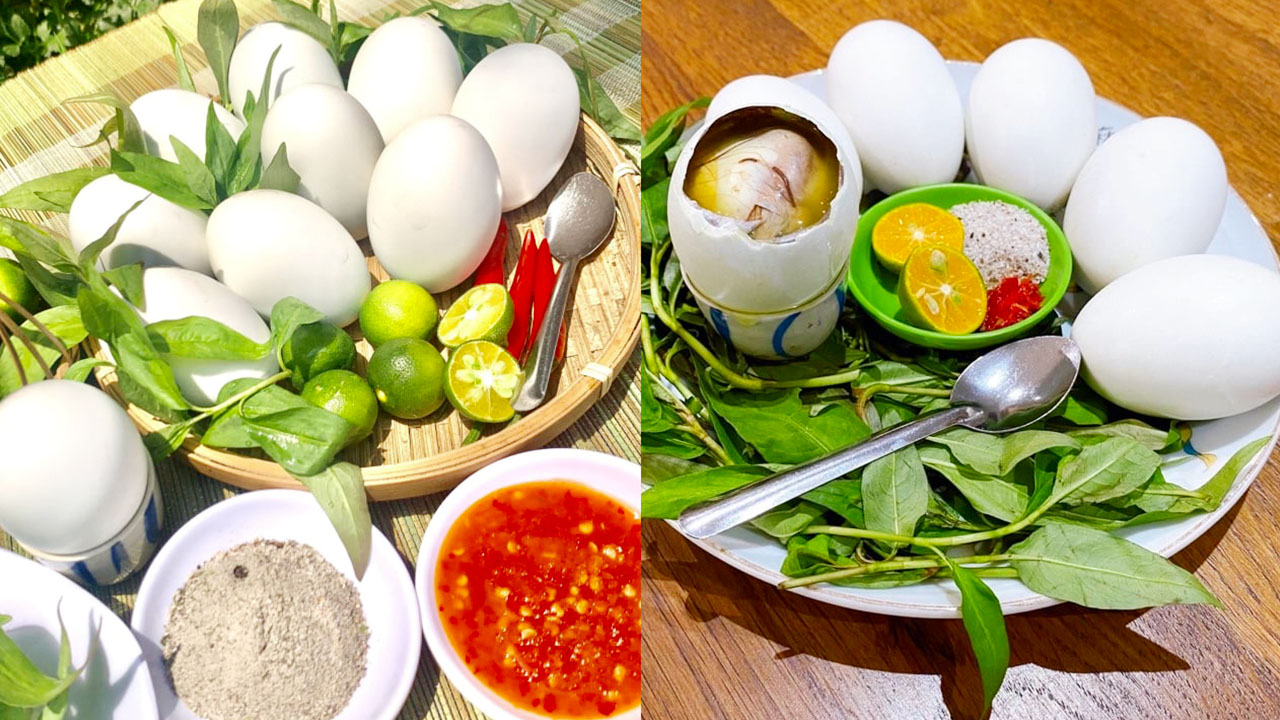
Balut has transcended its traditional roots, finding a place in Vietnam’s modern culinary landscape. Chefs and food enthusiasts are reinventing this classic dish, incorporating innovative techniques and presentations that appeal to contemporary palates.
Contemporary Adaptations
In modern Vietnamese cuisine, balut is being reimagined in various creative ways:
- Balut Salad: This dish combines balut with mixed greens, fresh herbs like cilantro and mint, and a light dressing made from soy sauce and vinegar. The salad provides a refreshing balance, highlighting the rich flavors of the egg while adding a crisp, fresh element.
- Balut Stir-Fry: By stir-frying balut with tamarind sauce, garlic, and vegetables, chefs create a tangy, savory dish that complements the richness of the egg. Peanuts and herbs are often added for extra texture and flavor.
- Balut Rice Bowl: A more contemporary take involves serving balut over a bed of rice, garnished with sautéed vegetables, herbs, and a drizzle of soy sauce or chili oil. This presentation makes balut more accessible and visually appealing to newcomers.
Culinary Innovation
Innovative chefs are also incorporating balut into fusion cuisine, blending traditional Vietnamese flavors with global culinary techniques:
- Balut Sushi: Some fusion restaurants offer balut sushi, where slices of the embryo and yolk are delicately placed atop sushi rice and wrapped in seaweed. This blend of Japanese and Vietnamese culinary traditions offers a novel way to experience balut.
- Balut Tacos: An unexpected yet delightful fusion can be found in balut tacos, where the elements of balut are combined with fresh salsa, cilantro, and a squeeze of lime inside a soft tortilla. This inventive dish provides a unique twist on both Vietnamese and Mexican street foods.
These contemporary adaptations demonstrate balut’s versatility and its capacity to evolve while still honoring its traditional roots.
Conclusion and Personal Experience
Balut, known as “trứng vịt lộn” or “hột vịt lộn” in Vietnamese, captures the essence of Vietnam’s culinary diversity and cultural richness. Whether enjoyed in its traditional form at a bustling street stall or as part of a modern, fusion dish in a contemporary restaurant, balut offers a unique gastronomic journey.
Personal Reflection
Trying balut for the first time can be a daunting experience, especially for those unfamiliar with its appearance and preparation. However, it often turns out to be a rewarding adventure, blending complex flavors and textures that are both savory and satisfying. The process of cracking open the egg, sipping the warm broth, and savoring the yolk and embryo creates a connection to Vietnamese culture that is profound and memorable.
The emotional journey associated with balut from initial apprehension to appreciation reflects its deeper significance beyond being just a food item. For locals, it is a cherished part of their culinary heritage, while for tourists, it serves as an intriguing introduction to the country’s vibrant street food scene.
Ultimately, balut embodies the spirit of Vietnamese hospitality and culinary tradition, inviting everyone to explore and savor its unique flavors. Embracing this experience can open doors to a deeper understanding and appreciation of Vietnam’s rich cultural landscape.
By exploring balut through the lenses of history, preparation methods, nutritional benefits, and culinary innovations, one can truly appreciate the depth and complexity of this remarkable dish. Whether you are a local or a visitor, tasting balut offers not only a culinary delight but also a meaningful connection to the heart of Vietnamese culture.


